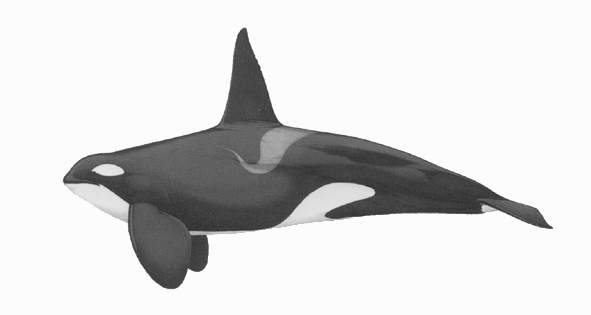The (Orca) Killer Whale
(Orcinus orca)
The Killer whale is the largest member of the dolphin family. This distinctive jet-black, brilliant white and grey marked, huge dorsal finned male, makes this animal relatively easy to identify. The female and juvenile, at a distance however, can be confused with Risso's dolphin, the False Killer whale and even Dall's Porpoise. The Orca can grow to a length of 7m (23ft) and weigh 4-5,000 kg in the male and 6.6m (21ft) 2.5-3,000 kg in the female.
Killer whales in the wild have a life expectancy that approximates that of humans. It's entirely possible it could be even longer. Free-ranging female Killer whales life spans 80 - 90 years or more while it's male counterpart 60 - 70 years or more.
Despite it's name, the Killer whale has never hurt a person in the wild. It is inquisitive and approachable and aggression within a pod is rare. The pod is a close-knit family group and is stable from one generation to the next. It's members usually stay together for life. When two or more pods come together temporarily the group is called a "superpod" and may number more than 150 whales. Usually larger groups split up into two or more smaller ones as the population grows. These groups of closely related pods (clans) often develop their own dialects.

The head of the Killer whale is conical-shaped. It has an indistinct beak with a conspicuous white oval patch above and behind the eye. It's jaw is broad with relatively few large conical teeth, 10-12 pairs in each jaw, and very powerful muscles to the rear of the upper jaw. These aid the retainment of large prey that would normally resist capture.
The Orca is a versitile predator and has one of the most varied diets of all whales. Although it has been observed feeding upon penguins, seals, porpoise and large baleen whales it's reputation for doing so is probably exaggerated. For most populations of Killer whales the diet appears to be primarily fish such as salmon and cod, and squid. It's consumption of birds, penguins, sea turtles, seals, and porpoise undoubtedly depends upon local availability.
Family: Delphinidae.
Subfamily: Globicephalinae
Other Names: Orca, Great Killer Whale, Grampus.
More Killer whales live in cooler waters, especially polar regions, than tropical and subtropical regions. They are found in all seas including the Western Mediterranean, Arabian Sea and the Gulf of Aden. The largest population seems to be in Antarctica where it is estimated some 160,000 animals range.
Sightings of Killer whales are usually restricted to within 800km (500 miles) of shore. Large concentrations are usually found over the continental shelf where they prefer deep water. Sightings within the surf zone although not as common include shallow bays, inland seas and estuaries but rarely in rivers. Although the Orca has no regular long migration ice cover attributes to it's local movement in high latitudes and food availability elsewhere. Studies suggest that Killer whales adopt one of two movement characteristics called "transients" or "residents". Transients tend to form smaller pods (1 to 7), roam over a wider area, feed predominantly on mammals, vocalise less frequntly, make abrupt changes in swimming direction, and often stay underwater for 5 to 15 minutes at a time. They also have a more pointed, centrally positioned dorsal fin than residents. Residents tend to form larger pods (5 to 25), have smaller home ranges, feed mainly on fish, vocalise frequently, keep to predictable routes, and rarely stay underwater for more than 4 minutes at a time.
Regarded as too small by the commercial whalers the Killer whale population has not been depleted. While early whaling practices have accounted for Killer whale deaths and indeed many other small cetaceans, it is defined as 'subsistance' or 'aboriginal' whaling and refers to the catching of whales from small boats (or from the beach) to satisfy material and cultural needs in local communities. The indians of Vancouver and Washington on the Pacific coast of North America hunted the Gray whale and the Killer whale in this manner and for these reasons.
Opportunistic hunting applies to modern whale catchers everywhere. With a fast boat and the right equipment its hard to pass up an easy kill so it is not uncommon for vessels from the Faroes catching Fin whales to harvest small species such as Killer whales and Atlantic White-sided Dolphin. Between 1938 and 1967 the Norwegians took 1,400 Killer whales in the Northeast Atlantic. During it's 1979-80 Southern Hemisphere whaling season the Soviet fleet targeted the Killer whale, with 916 killed, along with many larger species. A perceived conflict between man and whale in pursuit of a common source of food has led to many Killer whale deaths in the Icelandic and Norwegian herring fisheries.
| Bibliography | Whales on the Net |